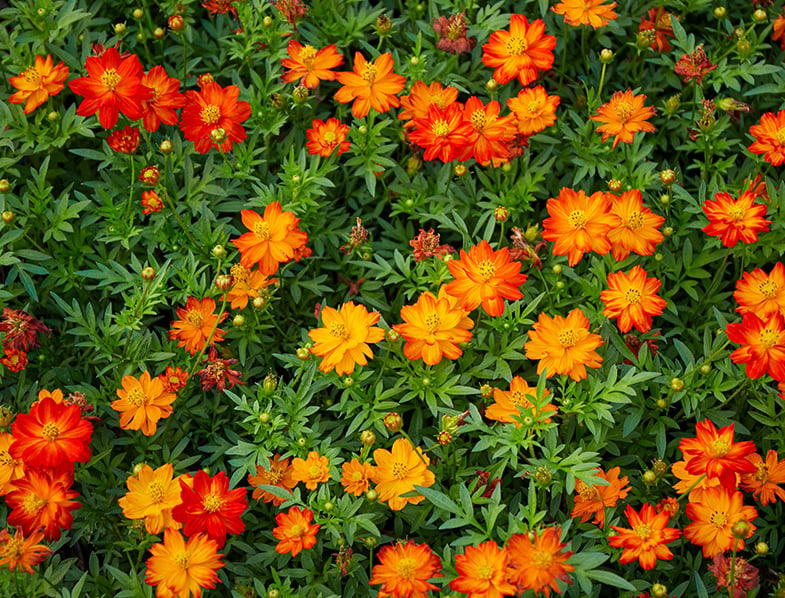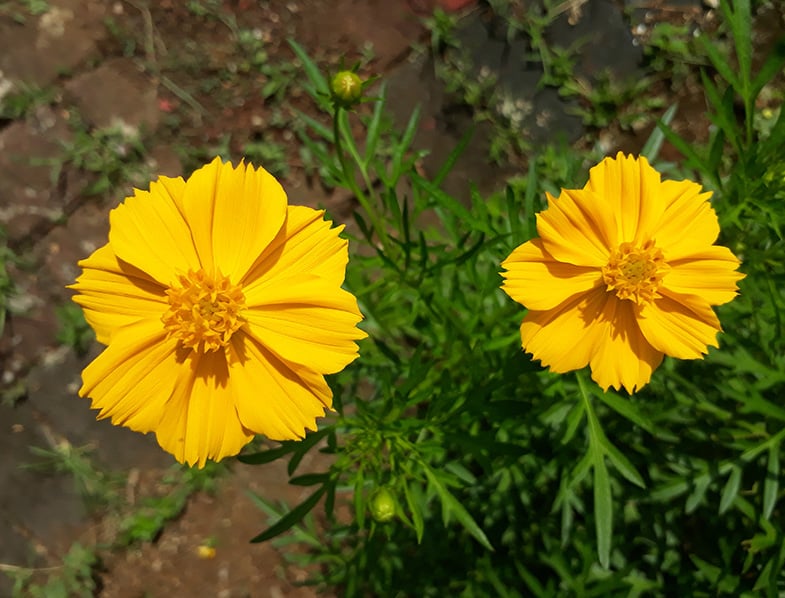Summer doesn’t feel right without at least one mesmerizing flower around. Although you might think that your collection is complete, there is always room for one more baby plant! And, believe us, this particular plant will put a smile on your face each time you walk into your garden or house. All it takes is a leap of faith!
Cosmos sulphureus, commonly known in cultivation as Yellow Cosmos or Sulfur Cosmos, is species of flowering plant in the Asteraceae family. This stunning, vibrant-coloured flower is usually an annual, but it can occur again for several years through self-sowing.
Cosmos sulphureus is native to several arid regions of Central America, northern South America, and Mexico. With time, it has become naturalized in numerous parts of Asia, Europe, and Australia thanks to its irresistible presence and easy-going style. And this plant is not an interesting specimen only for gardeners worldwide! Its flowers are also highly attractive to some species of birds and butterflies, especially the monarch butterfly.
About Cosmos Sulphureus
- The most common cultivars of Cosmos sulphureus include ‘Brightness Red’, ‘Ladybird Dwarf Orange’, ‘The Diablo’, ‘The Polidor’, ‘The Sunset’, and ‘Tango’.
- Due to their delicate and colourful flowers, several cultivars of Cosmos sulphureus have gained the well-known Award of Garden Merit.
- Some studies have suggested that Cosmos sulphureus may have numerous beneficial properties, such as antibacterial, anti-inflammatory, antioxidant, hepatoprotective, or repellent.
- Their leaves and rhizomes played a big part in traditional medicine. Many folks used them as a treatment for malaria, intermittent fever, jaundice, wounds, and as a tonic.
- The flowers of Cosmos sulphureus work as an excellent ingredient to obtain a biodegradable and eco-friendly dye. This product works best with wool.
- The young shoots and leaves are edible. People consume them as raw vegetables or cooked in several recipes that include rice, such as ‘gudang’ or ‘lalab’ in Indonesia.
- Their blossoms are also safe to eat. Not only do they add a dash of colour to salads or fruit dishes, but they also have a lovely mango-like flavour.
- Cosmos sulphureus plants are great additions to cottage gardens, cutting gardens, beds and borders, meadows, prairies, or containers. They are especially popular ornamentals in Japan and Korea, often seen in mass plantings along roadsides.

Cosmos Sulphureus Features: An Overview
- They belong to the Cosmos genus that contains about 40 species of flowering plants. The most popular Cosmos species are C. atrosanguineus, C. bipinnatus, and C. sulphureus.
- Cosmos sulphureus plants are annuals that can reach from 1 to 7 feet (0.3-2.1 m) in height and 1 to 3 feet (0.3-0.9 m) in width. If they are self-seeding properly, you can grow them as perennial plants for years.
- Their long, upright, and hairy stems come along with several dark green, pinnate leaves of about 12 inches (30 cm) in length. The leaves grow oppositely arranged on stems and have lanceolate leaflets.
- These plants bloom from early summer to mid-autumn (June-September). During this period, they exhibit numerous daisy-like, semi-double to double flowers of up to 2.5 inches (6.4 cm) in diameter.
- Depending on the cultivar, their blossoms can appear in various shades of yellow, orange, or red. They usually have greenish to yellow flower discs.
- Once their blooming period has ended, the fruits start to appear where their flowers once were. They are achenes of 0.8 inches (2 cm) in length that contain many black seeds.
- Cosmos sulphureus plants look absolutely gorgeous near other species of flowers including Annual Sage, Black-Eyed Susan, Floss Flower, Lavender, Rose Campion, and Tall Verbena.
Growing Cosmos Sulphureus
Cosmos sulphureus plants grow only in arid regions, so they will thrive if you manage to simulate the conditions from those environments. But do not worry, this is a good thing! In general, arid-native species do not require too much effort on your part to grow healthy and happy. Now keep reading to see for yourself how easy is to grow and care for these beauties.
In terms of lighting, Cosmos sulphureus plants do well in the brightest area you can find. Make sure you grow these flowers in a location where they can receive plenty of full sunlight daily. Indoors, place your potted plants near east or south-facing windows for the best lighting ever. They can also grow in partial shade but will not be as vigorous and neither show as many blooms as usual.
- Large flowers with orange and yellow hue, bloom from midsummer on, wonderful for cutting.
- Annual; Grows up to 30-40 Inches
- Prefers full sun exposure
- Tolerates poor soil, heat and humidity. Grows best in full sun
- Attracts Butterflies.
- 🌼 Dwarf Lemon Sulphur Cosmos do well in hot, arid climates. It is native to Central America and can grow in temperatures up to and above 100° F. The Cosmos sulphureus has a smaller flower than the Cosmos bipinnatus.
- 🌱 Cosmos Sulphur Dwarf Lemon Yellow flowers are a wonderful choice for adding color to your landscaping. All Cosmos attract birds and make good cut flowers. This flower does better if planted in soil that is more infertile.
- ☀️ 🐝 🦋 These seeds will yield stunning & beautiful yellow pedaled flowers. Makes beautiful center pieces for table! Conversation starter in your home flower garden!
- 👨🌾 Product Type: Flower - Color: Yellow - Cycle: Annual - Origin is Introduced - Height: 12-24" - Germination Time: 7-21 days - Planting Season: Spring - Bloom Season: Spring, Fall - Weeks to Bloom: 9 to 10 weeks
- 🌎 USDA Zones: 3, 4, 5, 6, 7, 8, 9, 10
- Cosmos bipannatus yellow lemonade flowers grow best in full sun to partial shade. Grow as an annual garden plant USDA Zones 3 - 10.
- Not too tall or too short, not too late blooming, not too wimpy, but just right! It only takes a few months after planting for this yellow cosmos to flower with 2.5 inch primrose yellow blooms all around the dense rounded 30 inch x 30 inch bright green foliage.
- Cosmos lemonade is a very tall plant growing up to 30 inches tall!
- A perfect yellow color is sure to enrich any flower garden. Elegant cut flowers and great and attracting butterflies! For the best flower production plant in soils of average fertility with moderate water.
- For best planting results, sow 6 cosmos seeds per plant and space 24 inches apart. Cut flowers typically last 5 to 9 days when blooms are cut as petals unfold. Flowers fully open in vase. Cosmos attract birds, bees and butterflies.
Last update on 2024-09-27 / Affiliate links / Images from Amazon Product Advertising API
Cosmos sulphureus plants can tolerate almost any humidity level out there. When it comes to temperatures, hot weather that mimics their natural habitat is perfect for these babies. They are somehow half-hardy plants but will need some winter protection from freezing temperatures. If you live in a region with harsh winters, it is wise to plant your flowers in pots and bring them inside in autumn.
Some species of pests like aphids, thrips, slugs, or gray mold can bother Cosmos sulphureus plants from time to time. Usually, you can notice these intruders pretty easily on your plants and handpick them right away. In case of severe infestation, apply a spray of horticultural oil or suitable insecticides/pesticides regularly.
Planting Cosmos Sulphureus
Although Cosmos sulphureus plants can grow in poor soil along with other flowers, they prefer neutral to slightly acidic substrates. They are susceptible to root rot, so you should plant them in soil that has excellent drainage. Avoid growing mediums that are too rich in nutrients and organic matter because they can produce taller plants that flop over.
If your plants tend to grow like crazy and cannot stand on their feet, you might want to provide them with some external support. Moreover, in the case of potted plants, make sure you are planting them in containers that have drainage holes at the bottom.
Cosmos sulphureus plants are usually pretty independent and do not require frequent fertilizing. In fact, too much fertilizer can actually have a negative impact, especially on potted plants. But if your flowers seem to be struggling overall, feed them with an all-purpose liquid fertilizer once a year in spring.
You can prolong their blooming period by deadheading your Cosmos sulphureus plants regularly. When you notice spent or dead flowers, remove them with bare hands to make room for new ones to flourish. Also, shearing back about one-third of your plants when most of the blossoms have faded can promote another wave of leaves and flowers.
Watering Cosmos Sulphureus
What makes Cosmos sulphureus plants very hard to resist is their ability to tolerate drought for relatively long periods. This feature is an all-time favourite, especially for growers that are quite forgetful by nature or do not have so much experience in the gardening world. However, your plants will demand regular watering until they settle in their new environment.
First things first, you will want to avoid over-watering at any cost during this episode. To make this happen, make sure you always check the soil in-between waterings. In their youth, Cosmos sulphureus flowers like substrates that are constantly damp. When the first inch (2.5 cm) of soil feels dry to the touch, your thirsty plants will appreciate a touch of water.
Once established, Cosmos sulphureus flowers may not require water at all. In case of a prolonged drought, you can provide your plants with a nice soaking once every week.

Propagating Cosmos Sulphureus
Why bother buying nursery seedlings when you can make your own Cosmos sulphureus babies at home? Not only this process is less expensive, but you can also have some fun along the way! These plants produce numerous seeds that can serve as an excellent propagation material, so find your courage and let’s make it happen!
In general, propagating Cosmos sulphureus plants through seeds is one of the easiest methods possible. All you have to do is collect the seeds from the mother plants and sow them either indoors or outdoors. Although some recommend precise spacing between each seed, it is better to scatter them around to allow the flowers to provide support one for another.
The perfect time for sowing indoors is somewhere around four to six weeks before the last frost of winter. If you want to start seeds outdoors, do not sow them unless all danger of frost has passed. For the propagation medium, fill a container or bed with a seed-starting mix.
Cosmos sulphureus seeds usually germinate in one to three weeks after sowing, followed by blooming in 50-60 days. However, germination will occur only if you expose the seeds at temperatures of 75 °F (24 °C). When the spring starts to show its warmth, you can transplant the seedlings in the garden or their individual pots.
In Conclusion
All flowers are gifts from nature that bring a lovely touch of warmth and colour into this world. And Cosmos sulphureus plants are no different! It is safe to say that these beauties are a must-have in every respectable collector’s plant family. Let yourself be charmed by their cute overall look and low-maintenance habit and you will not regret it!



